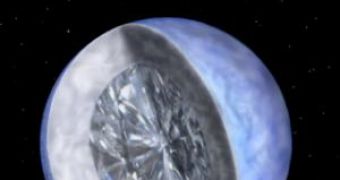Diamond is the hardest known natural material, with exceptional hardness and high dispersion of light, that makes it useful for industrial applications, but mostly for jewelry.
They are generally small and naturally occur in perfect to semiperfect octahedra, that is a three dimensional geometrical object that has eight faces.
The formation of natural diamond requires very specific conditions, like exposure of carbon-bearing materials to high pressure, ranging approximately between 45 and 60 kilobars, but a comparatively low temperature range between approximately 1600-2370F (900-1300C). These conditions are known to be met in two places on Earth: the litospheric mantle below relatively stable continental plates, and at the site of a meteorite impact.
The weight of the diamond is measured in carats, one carat being a fifth of a gram, or exactly 200 milligrams (about 0.007 ounce). The actual value of the diamond increases exponentially in relation to carat weight, since larger diamonds are both rare and more desirable for use as gemstones.
The Cullinan Diamond, part of the British crown jewels, was the largest gem-quality rough diamond ever found (1905), at 3,106.75 carats. One of the diamonds cut from it, Cullinan I or the Great Star of Africa, was formerly the largest gem-quality cut diamond at 530.2 carats, but now that title has been taken by the Golden Jubilee (1985), a 545.67 carat, yellow-brown diamond. The largest flawless and colorless (grade D) diamond is the Centenary Diamond, which weighs 273.85 carats. The Millenium Star is the second largest (1990) at 203.04 carats.
A commercial slogan goes like this: "Diamonds are forever", and a popular saying states that "Diamonds are a girl's best friend"
I am sure that none of the richest people on Earth could afford to buy this diamond: the galaxy's largest diamond is a 10 billion trillion trillion carat monster that a has a literally astronomical cost!
The huge cosmic gem, that completely outclasses the largest diamond on Earth, (technically known as BPM 37093) is actually a crystallized white dwarf. A white dwarf is the hot core of a star, left over after the star uses up its nuclear fuel and dies. It is made mostly of carbon and is coated by a thin layer of hydrogen and helium gases.
The newly discovered cosmic diamond is a chunk of crystallized carbon 50 light-years from the Earth in the constellation Centaurus. (A light-year is the distance light travels in a year, or about 6 trillion miles.) It is 2,500 miles across and weighs 5 million trillion trillion pounds, which translates to approximately 10 billion trillion trillion carats, or a one followed by 34 zeros.
For more than four decades, astronomers have thought that the interiors of white dwarfs crystallized, but obtaining direct evidence became possible only recently, when astronomer Travis Metcalfe (Harvard-Smithsonian Center for Astrophysics), who leads a team of researchers, discovered the giant gem.
"The hunt for the crystal core of this white dwarf has been like the search for the Lost Dutchman's Mine. It was thought to exist for decades, but only now has it been located," says co-author Michael Montgomery (University of Cambridge).
Scientist are now convinced that our Sun will become a white dwarf when it dies 5 billion years from now. Some two billion years after that, the Sun's ember core will crystallize as well, leaving a giant diamond in the center of our solar system, so our Sun will become a diamond that truly is forever.

 14 DAY TRIAL //
14 DAY TRIAL //